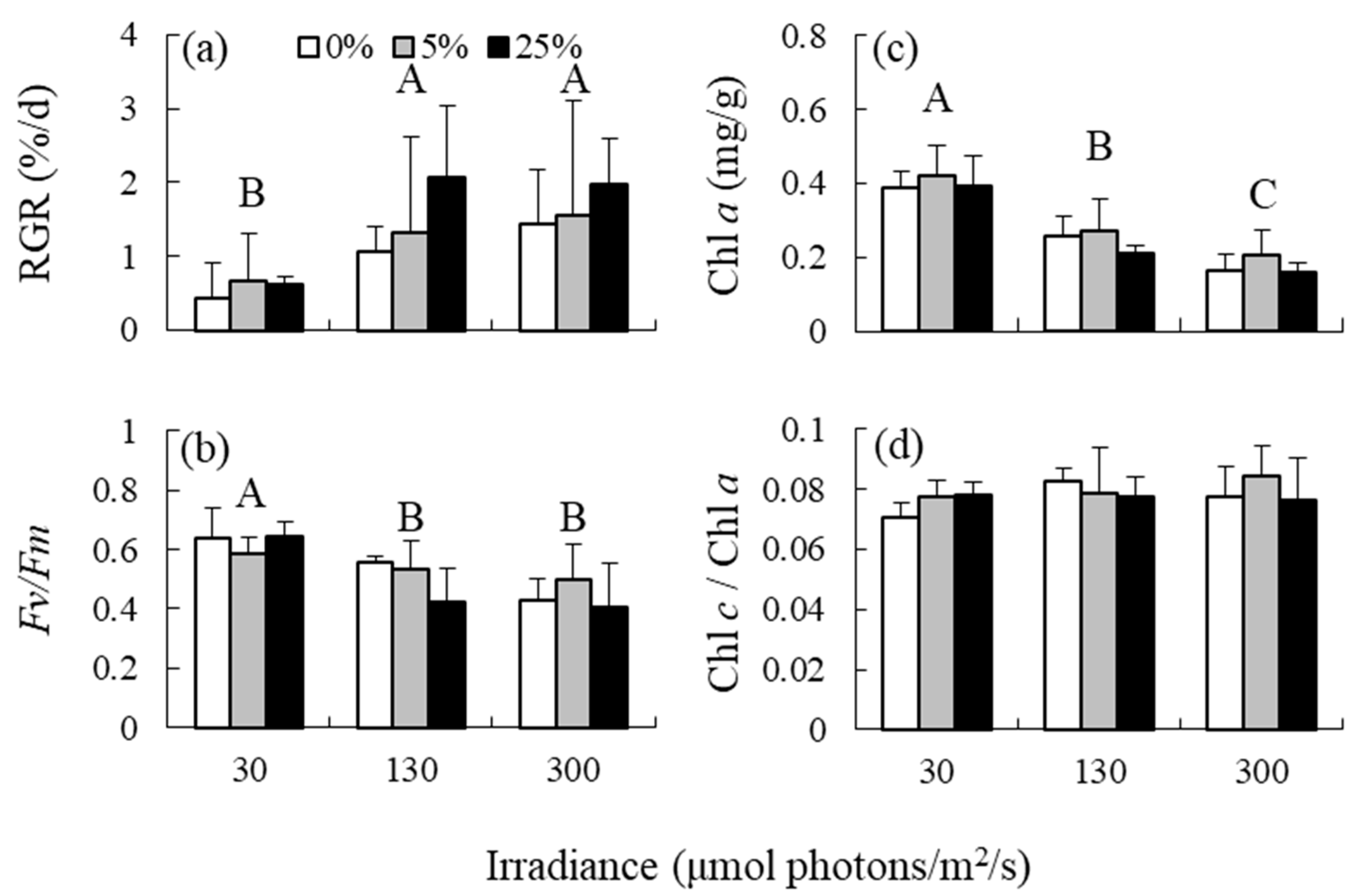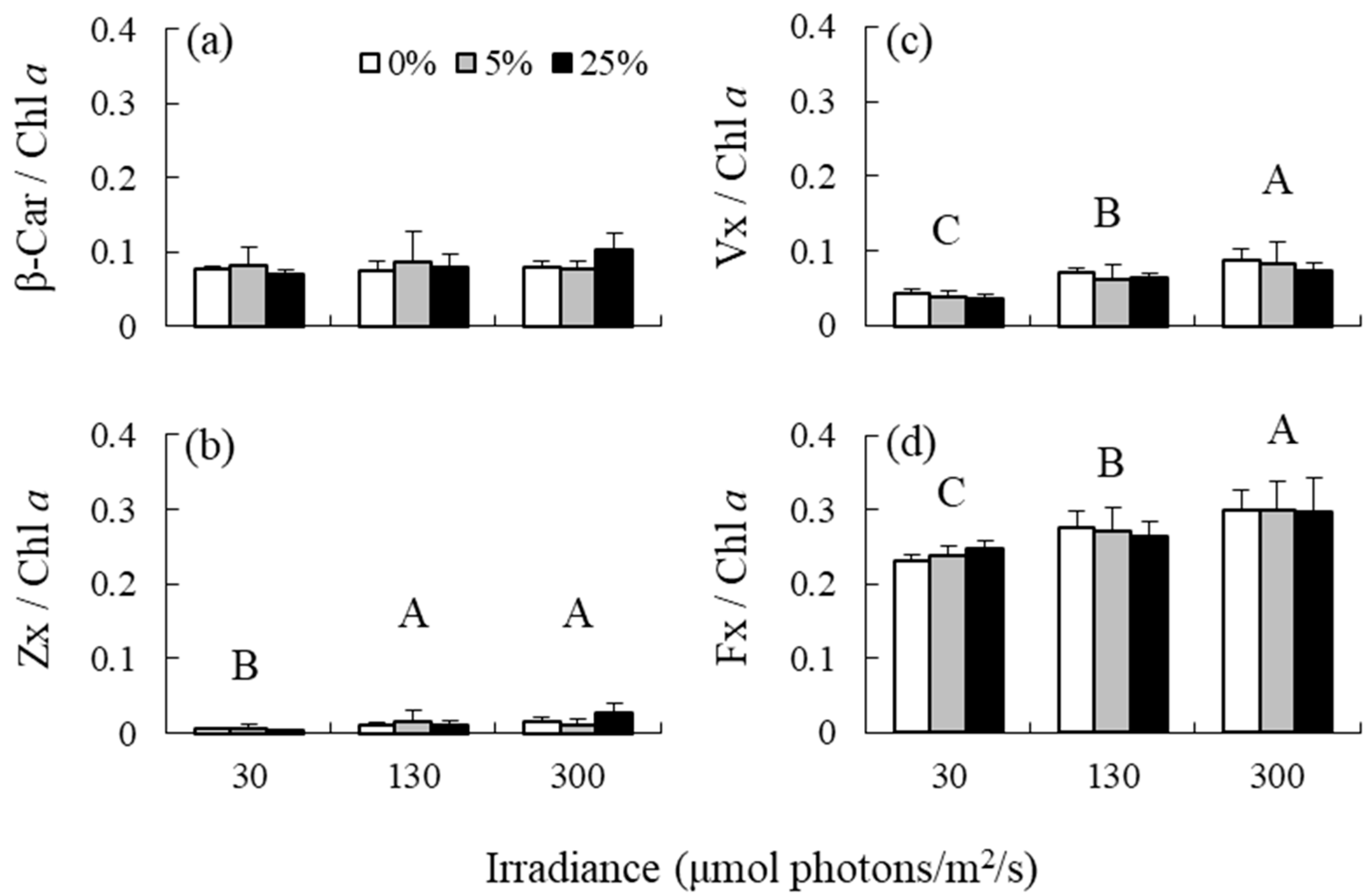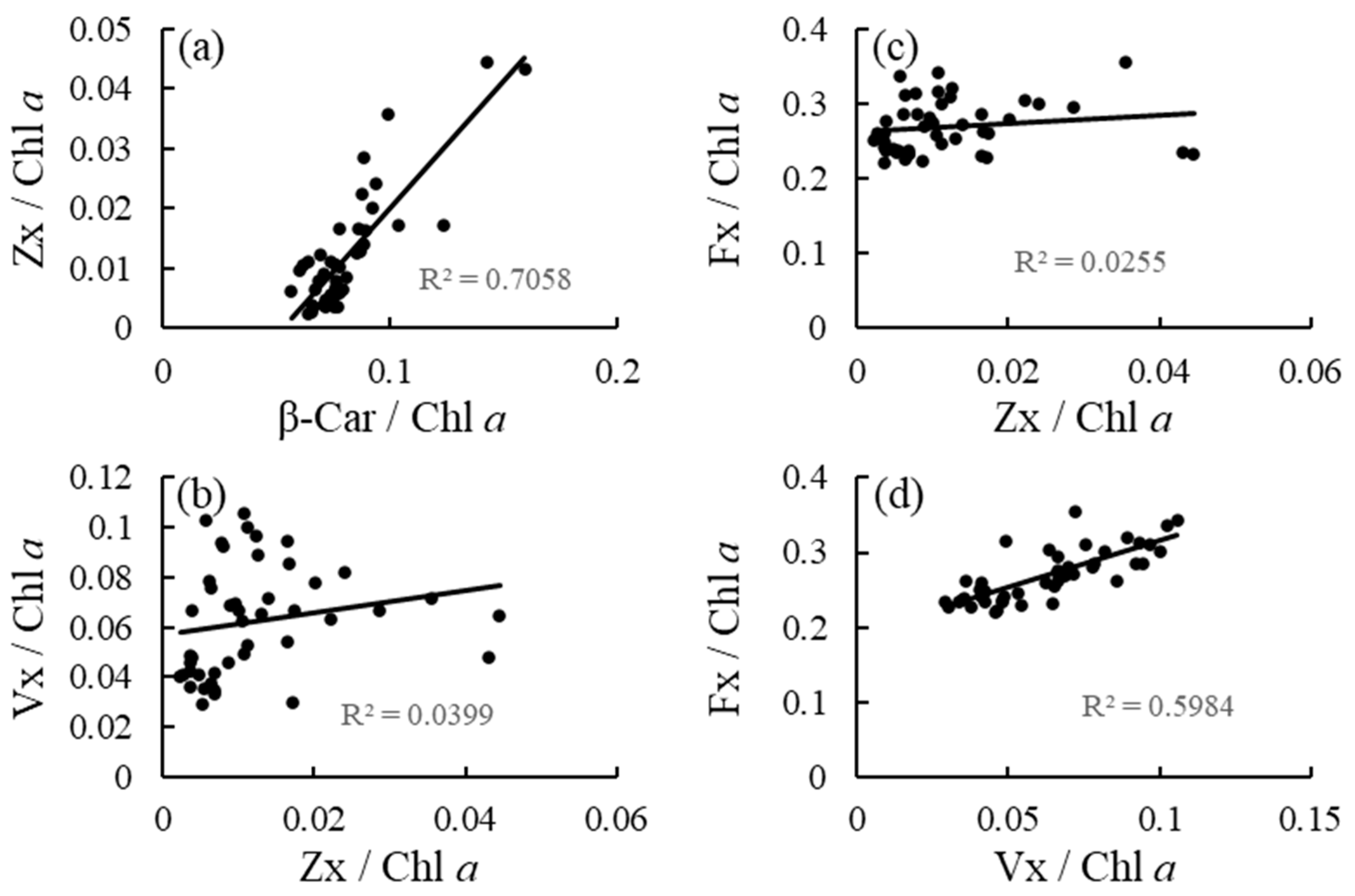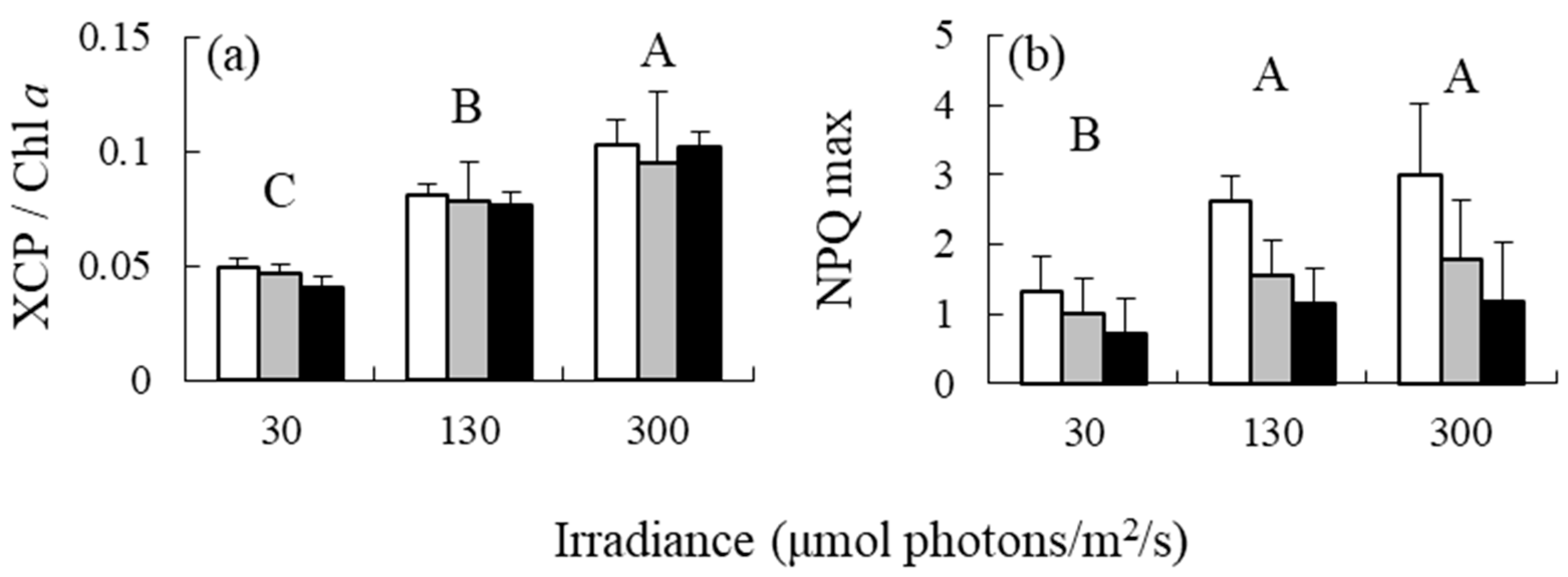Photoinhibition and Photoprotective Responses of a Brown Marine Macroalga Acclimated to Different Light and Nutrient Regimes
Abstract
:1. Introduction
2. Materials and Methods
2.1. Sample Preparation
2.2. Culture Experiment
2.3. Pigment Analyses
2.4. Statistical Analyses
3. Results
4. Discussion
5. Conclusions
Author Contributions
Funding
Institutional Review Board Statement
Informed Consent Statement
Data Availability Statement
Acknowledgments
Conflicts of Interest
References
- Murata, N.; Takahashi, S.; Nishiyama, Y.; Allakhverdiev, S.I. Photoinhibition of photosystem II under environmental stress. Biochim. Biophys. Acta Bioenerg. 2007, 1767, 414–421. [Google Scholar] [CrossRef]
- Takahashi, S.; Badger, M.R. Photoprotection in plants: A new light on photosystem II damage. Trends Plant. Sci. 2011, 16, 53–60. [Google Scholar] [CrossRef]
- Pintó-Marijuan, M.; Munné-Bosch, S. Photo-oxidative stress markers as a measure of abiotic stress-induced leaf senescence: Advantages and limitations. J. Exp. Bot. 2014, 65, 3845–3857. [Google Scholar] [CrossRef]
- Goss, R.; Lepetit, B. Biodiversity of NPQ. J. Plant Physiol. 2015, 172, 13–32. [Google Scholar] [CrossRef]
- Havaux, M.; Dall’Osto, L.; Bassi, R. Zeaxanthin has enhanced antioxidant capacity with respect to all other xanthophylls in Arabidopsis leaves and functions independent of binding to PSII antennae. Plant Physiol. 2007, 145, 1506–1520. [Google Scholar] [CrossRef]
- Mikami, K.; Hosokawa, M. Biosynthetic pathway and health benefits of fucoxanthin, an algae-specific xanthophyll in brown seaweeds. Int. J. Mol. Sci. 2013, 14, 13763–13781. [Google Scholar] [CrossRef]
- Kromdijk, J.; Głowacka, K.; Leonelli, L.; Gabilly, S.T.; Iwai, M.; Niyogi, K.K.; Long, S.P. Improving photosynthesis and crop productivity by accelerating recovery from photoprotection. Science 2016, 354, 857–861. [Google Scholar] [CrossRef]
- Ruban, A.V.; Wilson, S. The mechanism of non-photochemical quenching in plants: Localization and driving forces. Plant Cell Physiol. 2021, 62, 1063–1072. [Google Scholar] [CrossRef] [PubMed]
- Umena, Y.; Kawakami, K.; Shen, J.R.; Kamiya, N. Crystal structure of oxygen-evolving photosystem II at a resolution of 1.9 Å. Nature 2011, 473, 55–60. [Google Scholar] [CrossRef]
- Liu, Z.; Yan, H.; Wang, K.; Kuang, T.; Zhang, J.; Gui, L.; An, X.; Chang, W. Crystal structure of spinach major light-harvesting complex at 2.72 Å resolution. Nature 2004, 428, 287–292. [Google Scholar] [CrossRef]
- Ocampo-Alvarez, H.; García-Mendoza, E. Antagonist effect between violaxanthin and de-epoxidated pigments in nonphotochemical quenching induction in the qE deficient brown alga Macrocystis pyrifera. Biochim. Biophys. Acta Bioenerg. 2013, 1827, 427–437. [Google Scholar] [CrossRef]
- Xie, X.; Lu, X.; Wang, L.; He, L.; Wang, G. High light intensity increases the concentrations of β-carotene and zeaxanthin in marine red macroalgae. Algal. Res. 2020, 47, 101852. [Google Scholar] [CrossRef]
- Izuhara, T.; Kaihatsu, I.; Jimbo, H.; Takaichi, S.; Nishiyama, Y. Elevated levels of specific carotenoids during acclimation to strong light protect the repair of photosystem II in Synechocystis sp. PCC 6803. Front. Plant Sci. 2020, 11, 1030. [Google Scholar] [CrossRef]
- Endo, H.; Okumura, Y.; Sato, Y.; Agatsuma, Y. Interactive effects of nutrient availability, temperature, and irradiance on photosynthetic pigments and color of the brown alga Undaria pinnatifida. J. Appl. Phycol. 2017, 29, 1683–1693. [Google Scholar] [CrossRef]
- Charan, H.; Inomata, E.; Endo, H.; Sato, Y.; Okumura, Y.; Aoki, M.N. Decreased irradiance and nutrient enrichment mitigate the negative effect of ocean warming on growth and biochemical compositions of a canopy-forming marine macroalga. J. Mar. Sci. Eng. 2022, 10, 479. [Google Scholar] [CrossRef]
- Król, M.; Ivanov, A.G.; Jansson, S.; Kloppstech, K.; Huner, N.P. Greening under high light or cold temperature affects the level of xanthophyll-cycle pigments, early light-inducible proteins, and light-harvesting polypeptides in wild-type barley and the Chlorina f2 mutant. Plant Physiol. 1999, 120, 193–204. [Google Scholar] [CrossRef]
- Harrison, J.W.; Smith, R.E. Effects of nutrients and irradiance on PSII variable fluorescence of lake phytoplankton assemblages. Aquat. Sci. 2013, 75, 399–411. [Google Scholar] [CrossRef]
- Zhong, Z.H.; Wang, Y.; Qin, S.; Zhuang, L.C.; Li, J.J.; Song, W.L.; Liu, Z.Y. Short-term photoacclimation and photoregulation strategies of Sargassum horneri in response to temperature and light. Photosynthetica 2021, 59, 268–276. [Google Scholar] [CrossRef]
- Morales, F.; Abadía, J.; Abadía, A. Thermal energy dissipation in plants under unfavorable soil conditions. In Non-Photochemical Quenching and Energy Dissipation in Plants, Algae and Cyanobacteria; Demmig-Adams, B., Garab, G., Adams, W., III, Govindjee, Eds.; Springer: Dordrecht, The Netherlands, 2014; pp. 605–630. [Google Scholar]
- Su, B.; Wang, L.; Shangguan, Z. Morphological and physiological responses and plasticity in Robinia pseudoacacia to the coupling of water, nitrogen and phosphorus. J. Plant. Nutr. Soil Sci. 2021, 184, 271–281. [Google Scholar] [CrossRef]
- Petrou, K.; Kranz, S.A.; Doblin, M.A.; Ralph, P.J. Photophysiological responses of Fragilariopsis cylindrus (Bacillariophyceae) to nitrogen depletion at two temperatures. J. Phycol. 2012, 48, 127–136. [Google Scholar] [CrossRef]
- Rocha, G.S.; Parrish, C.C.; Lombardi, A.T.; da Graça Gama Melão, M. Biochemical and physiological responses of Selenastrum gracile (Chlorophyceae) acclimated to different phosphorus concentrations. J. Appl. Phycol. 2018, 30, 2167–2177. [Google Scholar] [CrossRef]
- Celis-Plá, P.S.; Brown, M.T.; Santillán-Sarmiento, A.; Korbee, N.; Sáez, C.A.; Figueroa, F.L. Ecophysiological and metabolic responses to interactive exposure to nutrients and copper excess in the brown macroalga Cystoseira tamariscifolia. Mar. Pollut. Bull. 2018, 128, 214–222. [Google Scholar] [CrossRef]
- Demmig-Adams, B.; Adams, W.W. Xanthophyll cycle and light stress in nature: Uniform response to excess direct sunlight among higher plant species. Planta 1996, 198, 460–470. [Google Scholar] [CrossRef]
- Coleman, M.A.; Wernberg, T. Forgotten underwater forests: The key role of fucoids on Australian temperate reefs. Ecol. Evol. 2017, 7, 8406–8418. [Google Scholar] [CrossRef]
- Wernberg, T.; Filbee-Dexter, K. Missing the marine forest for the trees. Mar. Ecol. Prog. Ser. 2019, 612, 209–215. [Google Scholar] [CrossRef]
- Smale, D.A. Impacts of ocean warming on kelp forest ecosystems. New Phytol. 2020, 225, 1447–1454. [Google Scholar] [CrossRef]
- Endo, H.; Sugie, T.; Yonemori, Y.; Nishikido, Y.; Moriyama, H.; Ito, R.; Okunishi, S. Vegetative reproduction is more advantageous than sexual reproduction in a canopy-forming clonal macroalga under ocean warming accompanied by oligotrophication and intensive herbivory. Plants 2021, 10, 1522. [Google Scholar] [CrossRef]
- Xu, L.; Luo, L.; Zuo, X.; Cao, C.; Lin, L.; Zheng, H.; Ma, Z.; Chen, B.; Wu, M. Effects of temperature and irradiance on the regeneration of juveniles from the holdfasts of Sargassum fusiforme, a commercial seaweed. Aquaculture 2022, 557, 738317. [Google Scholar] [CrossRef]
- Kokubu, S.; Nishihara, G.N.; Watanabe, Y.; Tsuchiya, Y.; Amamo, Y.; Terada, R. The effect of irradiance and temperature on the photosynthesis of a native alga Sargassum fusiforme (Fucales) from Kagoshima, Japan. Phycologia 2015, 54, 235–247. [Google Scholar] [CrossRef]
- Baba, M. Effects of temperature and irradiance on germling growth in eight Sargassaceous species. Rep. Mar. Ecol. Res. Inst. 2007, 10, 9–20. [Google Scholar]
- Jormalainen, V.; Ramsay, T. Resistance of the brown alga Fucus vesiculosus to herbivory. Oikos 2009, 118, 713–722. [Google Scholar] [CrossRef]
- Hanelt, D. Capability of dynamic photoinhibition in Arctic macroalgae is related to their depth distribution. Mar. Biol. 1998, 131, 361–369. [Google Scholar] [CrossRef]
- Bischof, K.; Hanelt, D.; Wiencke, C. Acclimation of maximal quantum yield of photosynthesis in the brown alga Alaria esculenta under high light and UV radiation. Plant Biol. 1999, 1, 435–444. [Google Scholar] [CrossRef]
- Zapata, M.; Rodríguez, F.; Garrido, J.L. Separation of chlorophylls and carotenoids from marine phytoplankton: A new HPLC method using a reversed phase C8 column and pyridine-containing mobile phases. Mar. Ecol. Prog. Ser. 2000, 195, 29–45. [Google Scholar] [CrossRef]
- Balfagón, D.; Sengupta, S.; Gómez-Cadenas, A.; Fritschi, F.B.; Azad, R.K.; Mittler, R.; Zandalinas, S.I. Jasmonic acid is required for plant acclimation to a combination of high light and heat stress. Plant Physiol. 2019, 181, 1668–1682. [Google Scholar] [CrossRef]
- Machalek, K.M.; Davison, I.R.; Falkowski, P.G. Thermal acclimation and photoacclimation of photosynthesis in the brown alga Laminaria saccharina. Plant Cell Environ. 1996, 19, 1005–1016. [Google Scholar] [CrossRef]
- Endo, H.; Gao, X.A. New classification tool and a systematic review of macroalgal studies disentangle the complex interactive effects of warming and nutrient enrichment on primary production. Front. Mar. Sci. 2022, 9, 774801. [Google Scholar] [CrossRef]
- Endo, H.; Inomata, E.; Gao, X.; Kinoshita, J.; Sato, Y.; Agatsuma, Y. Heat stress promotes nitrogen accumulation in meristems via apical blade erosion in a brown macroalga with intercalary growth. Front. Mar. Sci. 2020, 7, 575721. [Google Scholar] [CrossRef]
- Dietz, K.J. Efficient high light acclimation involves rapid processes at multiple mechanistic levels. J. Exp. Bot. 2015, 66, 2401–2414. [Google Scholar] [CrossRef]
- MacIntyre, H.L.; Kana, T.M.; Anning, T.; Geider, R.J. Photoacclimation of photosynthesis irradiance response curves and photosynthetic pigments in microalgae and cyanobacteria. J. Phycol. 2002, 38, 17–38. [Google Scholar] [CrossRef]
- Perez-Bermudez, P.; Garcia-Carrascosa, M.; Cornejo, M.J.; Segura, J. Water-depth effects in photosynthetic pigment content of the benthic algae Dictyota dichotoma and Udotea petiolata. Aquat. Bot. 1981, 11, 373–377. [Google Scholar] [CrossRef]
- Shelly, K.; Higgins, T.; Beardall, J.; Wood, B.; McNaughton, D.; Heraud, P. Characterising nutrient-induced fluorescence transients (NIFTs) in nitrogen-stressed Chlorella emersonii (Chlorophyta). Phycologia 2007, 46, 503–512. [Google Scholar] [CrossRef]
- Haan, J.D.; Huisman, J.; Dekker, F.; Ten Brinke, J.L.; Ford, A.K.; van Ooijen, J.; van Duyl, F.C.; Vermeij, M.J.A.; Visser, P.M. Fast detection of nutrient limitation in macroalgae and seagrass with nutrient-induced fluorescence. PloS ONE 2013, 8, e68834. [Google Scholar] [CrossRef]




| Irradiance | Nutrients | Irradiance * Nutrients | |||||||
|---|---|---|---|---|---|---|---|---|---|
| Variables | MS | F | p | MS | F | p | MS | F | p |
| RGR | 5.083 | 12.697 | <0.001 * | 1.282 | 3.201 | 0.053 | 0.273 | 0.681 | 0.609 |
| Fv/Fm | 0.122 | 13.886 | <0.001 * | 0.012 | 1.369 | 0.267 | 0.016 | 1.760 | 0.158 |
| Chl a | 0.199 | 56.553 | <0.001 * | 0.008 | 2.397 | 0.105 | 0.001 | 0.319 | 0.863 |
| Chl c/Chl a | <0.001 | 0.895 | 0.417 | <0.001 | 0.510 | 0.605 | <0.001 | 1.028 | 0.406 |
| β-Car/Chl a | 0.010 | 1.301 | 0.285 | 0.003 | 0.420 | 0.660 | 0.011 | 1.404 | 0.252 |
| Zx/Chl a | 0.989 | 18.868 | <0.001 * | 0.016 | 0.307 | 0.737 | 0.127 | 2.414 | 0.067 |
| Vx/Chl a | 0.367 | 40.958 | <0.001 * | 0.019 | 2.104 | 0.137 | 0.001 | 0.143 | 0.965 |
| Fx/Chl a | 0.034 | 19.115 | <0.001 * | <0.001 | 0.001 | 0.999 | 0.001 | 0.458 | 0.766 |
| XCP/Chl a | 0.449 | 73.771 | <0.001 * | 0.007 | 1.069 | 0.354 | 0.005 | 0.739 | 0.571 |
| DES | 0.014 | 1.769 | 0.185 | 0.010 | 1.199 | 0.313 | 0.017 | 2.162 | 0.093 |
| NPQ | 3.905 | 9.216 | <0.001 * | 6.439 | 15.196 | <0.001 | 0.556 | 1.311 | 0.284 |
Disclaimer/Publisher’s Note: The statements, opinions and data contained in all publications are solely those of the individual author(s) and contributor(s) and not of MDPI and/or the editor(s). MDPI and/or the editor(s) disclaim responsibility for any injury to people or property resulting from any ideas, methods, instructions or products referred to in the content. |
© 2023 by the authors. Licensee MDPI, Basel, Switzerland. This article is an open access article distributed under the terms and conditions of the Creative Commons Attribution (CC BY) license (https://creativecommons.org/licenses/by/4.0/).
Share and Cite
Endo, H.; Moriyama, H.; Okumura, Y. Photoinhibition and Photoprotective Responses of a Brown Marine Macroalga Acclimated to Different Light and Nutrient Regimes. Antioxidants 2023, 12, 357. https://doi.org/10.3390/antiox12020357
Endo H, Moriyama H, Okumura Y. Photoinhibition and Photoprotective Responses of a Brown Marine Macroalga Acclimated to Different Light and Nutrient Regimes. Antioxidants. 2023; 12(2):357. https://doi.org/10.3390/antiox12020357
Chicago/Turabian StyleEndo, Hikaru, Hikari Moriyama, and Yutaka Okumura. 2023. "Photoinhibition and Photoprotective Responses of a Brown Marine Macroalga Acclimated to Different Light and Nutrient Regimes" Antioxidants 12, no. 2: 357. https://doi.org/10.3390/antiox12020357
APA StyleEndo, H., Moriyama, H., & Okumura, Y. (2023). Photoinhibition and Photoprotective Responses of a Brown Marine Macroalga Acclimated to Different Light and Nutrient Regimes. Antioxidants, 12(2), 357. https://doi.org/10.3390/antiox12020357





